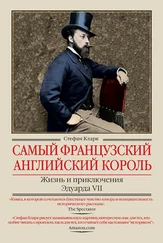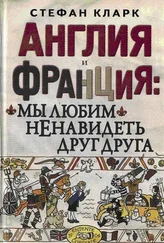Стефан Кларк - 1000 Years of Annoying the French
Здесь есть возможность читать онлайн «Стефан Кларк - 1000 Years of Annoying the French» весь текст электронной книги совершенно бесплатно (целиком полную версию без сокращений). В некоторых случаях можно слушать аудио, скачать через торрент в формате fb2 и присутствует краткое содержание. ISBN: , Издательство: Transworld Digital, Жанр: Старинная литература, на английском языке. Описание произведения, (предисловие) а так же отзывы посетителей доступны на портале библиотеки ЛибКат.
- Название:1000 Years of Annoying the French
- Автор:
- Издательство:Transworld Digital
- Жанр:
- Год:неизвестен
- ISBN:9781407067629
- Рейтинг книги:3 / 5. Голосов: 1
-
Избранное:Добавить в избранное
- Отзывы:
-
Ваша оценка:
- 60
- 1
- 2
- 3
- 4
- 5
1000 Years of Annoying the French: краткое содержание, описание и аннотация
Предлагаем к чтению аннотацию, описание, краткое содержание или предисловие (зависит от того, что написал сам автор книги «1000 Years of Annoying the French»). Если вы не нашли необходимую информацию о книге — напишите в комментариях, мы постараемся отыскать её.
1000 Years of Annoying the French — читать онлайн бесплатно полную книгу (весь текст) целиком
Ниже представлен текст книги, разбитый по страницам. Система сохранения места последней прочитанной страницы, позволяет с удобством читать онлайн бесплатно книгу «1000 Years of Annoying the French», без необходимости каждый раз заново искать на чём Вы остановились. Поставьте закладку, и сможете в любой момент перейти на страницу, на которой закончили чтение.
Интервал:
Закладка:
Folk ballads telling of a Robin Hood’s heroic exploits date back to the thirteenth century, and are mostly about resisting authority – not a surprising theme at a time when the common people were being worked almost literally to death by rich landowners, and could be hanged by a lord just because he felt like it. In a ballad called the Gest of Robyn Hood , written down at the end of the fifteenth century but apparently much older, ‘Robyn’ identifies his targets to his friend ‘Litell Johnn’ like this:
These bisshoppes and these archebishoppes,
Ye shall them bete and bynde;
The hye sherif of Notyngham,
Hym holde ye in your mynde.
Bishops, archbishops and the sheriff: the pillars of medieval authority, begging to get knocked down.
The Robin in these ballads doesn’t always give to the poor; in one of them, he lends a knight some money to repay a debt to an abbot. And in the early sources, there is almost no mention of Robin supporting King Richard against his brother John – this seems to have been added later to give Robin a higher cause than local wealth redistribution. In fact, to the average Englishman Richard was more of a financial burden than a king; in 1193 he was taken hostage by one of his many enemies, Henry VI of the Holy Roman Empire, who put in a ransom demand for 150,000 marks (about three times the English Crown’s annual income). The money was raised by massive across-the-board tax increases for the English, probably made worse by John, who offered 80,000 marks as a bribe to keep Richard in prison.
Richard’s release and return to save England from John’s mismanagement usually come as the dramatic ending to Robin Hood’s tale, but in fact Richard didn’t hang around long to show his gratitude to his English subjects – the call of war, and of French-bashing, was too strong. Looking to take advantage of the Lionheart’s spell behind bars, Richard’s old ally Philippe Auguste, now King Philippe II of France, was trying to seize English-held lands in Normandy and Anjou. So Richard immediately grabbed all the money he could lay his hands on and left England yet again, never to return.
The war with Philippe Auguste was apparently made worse by an intense personal animosity between the two men. It was rumoured that he and Richard had been lovers back in the days of their alliance against Henry II. That ardour had cooled, but the two had gone on a joint crusade in the Holy Land, and, as with so many exes, holidaying together had only made things worse. At the siege of the city of Acre in 1191, Richard took an active part in the fighting despite being seriously ill with scurvy, and was even reported firing a crossbow at the walls while lying on a stretcher. Philippe Auguste, meanwhile, was laid up with dysentery and stayed out of the action, provoking Richard into making some deeply wounding remarks about shirkers.
So Richard now devoted the remaining five years of his life to fighting France’s land-grabbing king. And he was so successful that, after the Battle of Gisors in northern France, in September 1198, he made the ultimate statement of his, and England’s, independence from the old feudal allegiance to the King of France. Until then, as a duke or count of French territories, Richard, like all English monarchs, had theoretically been a feudal vassal of Philippe Auguste. But now Richard adopted the royal motto that has survived to this day, ‘Dieu et mon droit’ (‘God and my right’) – a neat explanation, in French so Philippe Auguste would get the message, that an English king owed allegiance to no one but God. And even then he had his rights.
It was, however, France that finally killed Richard.
In March 1199, he was putting down a revolt by a minor French nobleman in his territory of Aquitaine, and was leading a routine siege of Châlus Castle, which was defended by only a few knights, one of whom was using a frying pan as a shield. Richard was feeling so confident of victory that he went wandering around the moat one evening without his chainmail, daring the castle’s defenders to shoot at him. Unfortunately, the one with the frying pan did just that, hitting Richard in the neck with a crossbow bolt. The wound became infected after an incompetent surgeon 4tried to pull the arrow out, and Richard was soon on his deathbed.
Legend has it that as the Lionheart lay dying, he had the offending French crossbowman brought to him for forgiveness. The soldier turned out to be a boy, probably called Pierre Basile, who told Richard that he had fired his arrow in revenge because the English had killed his father and brother. According to English versions of the story, Richard was so touched that he blessed the boy and gave him a large cash present.
Certain French sources allege that Richard treacherously had the archer killed, but this is an anti-English falsehood. What actually happened, it seems, is that immediately after Richard’s death on 6 April 1199, the leader of his mercenaries (who was himself French, by the way) had all Châlus Castle’s defenders brutally executed by hanging them from the ramparts. And he saved the cruellest punishment for young Pierre Basile, who was skinned alive, no doubt as punishment for shooting the hired soldiers’ rich employer.
But then French historians will say anything to tarnish an English king’s reputation.
A fond, and strangely peaceful, family reunion
In death, as in life, Richard spread himself thinly. His entrails were buried in the chapel of the castle where he died, at Châlus; his heart was taken to Rouen in Normandy; his brain was buried in Charroux Abbey in Aquitaine, and the rest of him went to take part in a touching, but rather surprising family reunion.
The Royal Abbey of Fontevraud, in the heart of Anjou, was founded in 1101, and resembles a castle as much as a religious community. It has forbidding outer walls, a gothic central courtyard that looks more like a jousting arena than a cloister, and a tower with a cluster of turrets like organ pipes (though they are in fact pointed chimneys). At its heart is a huge church, which is as pristine white as the rest of the buildings except for a few touches of colour in the middle of the nave that are fenced off to preserve the last flecks of paint from the ravages of history.
These are the decorated tombs of an unlikely collection of people. Here, lying side by side, their heads resting peacefully on stone pillows, are the effigies of Henry II and his estranged wife Eleanor of Aquitaine. And at their feet, apparently content for once to be in a position of inferiority, is their son Richard the Lionheart.
If there is an atmosphere of intense peace about the unlikely trio, it is probably because their bodies are no longer buried here – their mortal remains disappeared when the abbey was looted during the French Revolution. But it seems almost miraculous that they should ever have been reunited at Fontevraud, just a few kilometres from Chinon Castle, where Henry II died after losing a battle to Richard, and where Eleanor was locked up by her errant husband. The area can’t have conjured up many warm family memories.
They are all here because Eleanor seems to have decided that family comes first. Henry II had nominated the abbey as the Plantagenets’ royal mausoleum, and Eleanor, who outlived her husband by fifteen years and spent most of her final years at the abbey, respected his wishes. Although she seems to have had the last laugh – her effigy is several centimetres higher than his.
The only mystery is why John isn’t beside his brother Richard; there is a fourth tomb in the nave at Fontevraud, but it is that of John’s French wife Isabelle. The reason for John’s exclusion from the communal forgiveness seems to be that by the time he died, Fontevraud, along with the rest of Anjou and almost all of England’s other territories in France, had been lost. And guess whose fault that was …
Читать дальшеИнтервал:
Закладка:
Похожие книги на «1000 Years of Annoying the French»
Представляем Вашему вниманию похожие книги на «1000 Years of Annoying the French» списком для выбора. Мы отобрали схожую по названию и смыслу литературу в надежде предоставить читателям больше вариантов отыскать новые, интересные, ещё непрочитанные произведения.
Обсуждение, отзывы о книге «1000 Years of Annoying the French» и просто собственные мнения читателей. Оставьте ваши комментарии, напишите, что Вы думаете о произведении, его смысле или главных героях. Укажите что конкретно понравилось, а что нет, и почему Вы так считаете.












